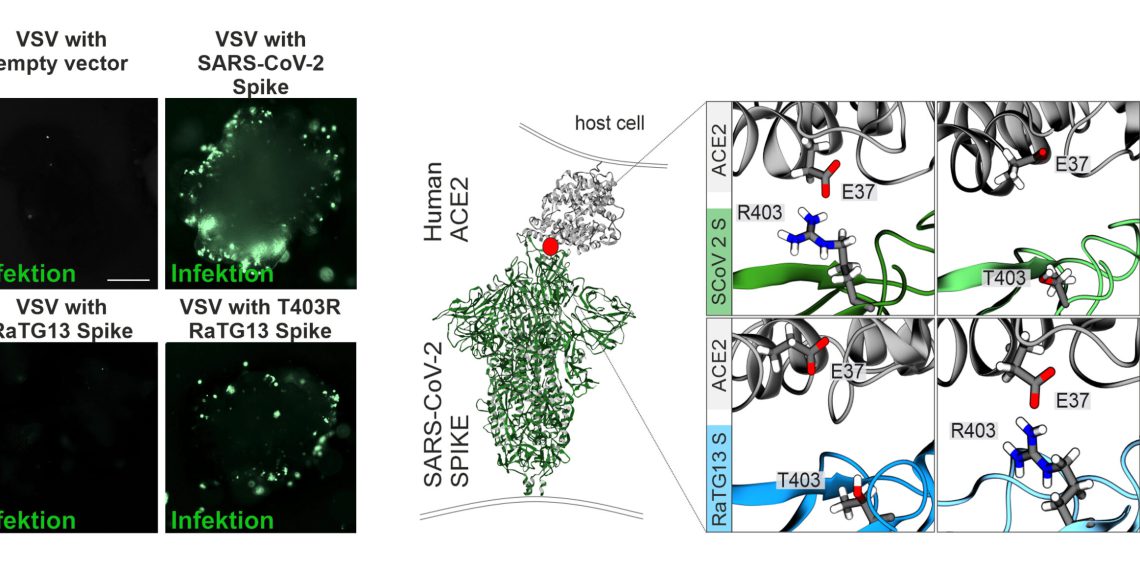The bat virus RaTG13 is a close relative of SARS-CoV‑2, but unlike the causative agent of the COVID-19 pandemic, RaTG13 is poor at docking to human cells. However, the exchange of a single amino acid in the spike protein of this bat coronavirus is sufficient for it to bind to human cells via the ACE2 receptor, similar to SARS-CoV‑2. This was shown in a study from the Institute of Molecular Virology at Ulm University Hospital, which was recently published in the journal Nature Communications. Another result of the work: A vaccination against SARS-CoV‑2 may possibly help to prevent the skipping of such pathogens.
The causative agent of the COVID-19 pandemic, SARS-CoV‑2, was most likely transmitted directly or via an intermediate host from bats to humans. The virus was able to spread so rapidly through the human population because it effectively infects human lung cells. The characteristics that allow bat viruses to jump to humans are currently poorly understood. What is known is that SARS-CoV‑2 can dock to the ACE2 receptor of human cells with its spike protein and thus invade the cells. A research team led by Ulm virologist Professor Frank Kirchhoff has now shown that the exchange of a single amino acid in the spike protein of the bat virus RaTG13 is sufficient for this protein to dock to human cells via the ACE2 receptor and lead to their infection. The results were published in the renowned journal Nature Communications.
“The targeted mutation of an amino acid in the spike protein of RaTG13, specifically at position 403, allows this bat coronavirus to dock to the same receptor as SARS-CoV‑2: the human ACE2 receptor.”
- Professor Frank Kirchhoff, head of the Institute of Molecular Virology at Ulm University Hospital
The research team was also able to reveal the basic mechanism that explains why the ACE2 receptor suddenly has such an attractive effect on the modified spike protein: “The exchanged amino acid in the spike protein of the virus is positively charged and interacts with a negatively charged amino acid in the human ACE2 receptor molecule,” said Fabian Zech, first author of the study and doctoral student at the Institute of Molecular Virology.
The scientific work is a perfect example of the interdisciplinary interaction between experimental laboratory work and theoretical computer modeling. On the one hand, the Ulm virus researchers altered the amino acid composition of the spike protein of the virus through the targeted generation of mutations (mutagenesis). On the other hand, computer-assisted modeling helped to elucidate protein structures and protein-protein interactions. These were carried out by Dr. Christoph Jung from Professor Timo Jacob’s Institute of Electrochemistry at the University of Ulm. So-called reactive force field methods were used to gain insights into physicochemical properties and interaction energies.
Reverse mutation makes SARS-CoV‑2 less infectious
In this scientific work, the virologists from Ulm not only succeeded in using genetic engineering to enable the spike protein of the bat coronavirus RaTG13 to infect human cells. They also demonstrated that a reverse mutation in SARS-CoV‑2 (R403T) weakens the pandemic agent and reduces viral infection of human cells. This result suggests that the positively charged amino acid is important for the high transmissibility of SARS-CoV‑2.
The research project has revealed which properties of coronaviruses are crucial for them to jump to humans as zoonotic diseases. The results thus help to better assess the risk of future viral pandemics. And there is another aspect that makes the study interesting: the researchers also investigated whether current vaccinations against SARS-CoV‑2 can protect against closely related bat viruses and thus against future zoonoses. The result: “Sera from individuals vaccinated against COVID-19 were effective in rendering the bat virus harmless. Thus, SARS-CoV‑2 vaccination could help prevent future spillover of such viral pathogens to humans,” the researchers said.
Virus researchers and infection biologists from Erlangen-Nuremberg, Munich and Göttingen as well as other Ulm scientists from electrochemistry, internal medicine and medical microbiology were involved in this research project of the Ulm Institute of Molecular Virology. The study — which has already been published as a preprint and met with great interest — was supported by the DFG (including from the Heisenberg Program), the BMBF, the Free State of Bavaria and the International Graduate School of Molecular Medicine (IGradU) at the University of Ulm. This scientific work was realized within the framework of the Ulm Collaborative Research Center 1279 “Use of the human peptidome for the development of new antimicrobial and anti-cancer therapeutics”.

















